人为灾害英语讲稿
英文灾难演讲稿范文

Today, I stand before you to address a grave issue that has recently affected our nation. It is with a heavy heart and a sense of urgencythat I bring to your attention the catastrophic disaster that has unfolded in our beloved country.The disaster, which struck without warning, has caused immense loss of life, property, and infrastructure. The scale of destruction is unprecedented, and it has left us in a state of shock and despair. It is a reminder of the fragility of life and the power of nature.First and foremost, I would like to extend my deepest condolences to the families who have lost loved ones in this tragedy. The pain you are experiencing is unimaginable, and we stand with you in solidarity during these difficult times. Our hearts go out to you, and we promise to support you in every way possible.The disaster has left a trail of destruction that stretches across our lands. Entire towns have been reduced to ruins, homes have been lost, and communities have been uprooted. The economic impact is colossal, and it will take years, if not decades, to rebuild what has been lost.In the face of such devastation, it is important to recognize the bravery and resilience of our people. First responders, volunteers, and ordinary citizens have shown immense courage in the aftermath of the disaster. They have risked their own lives to save others, and their actions have been a testament to the human spirit.However, we must also acknowledge the shortcomings in our preparedness and response mechanisms. It is clear that more needs to be done to ensure that our nation is better equipped to handle such emergencies. This includes investing in infrastructure, improving early warning systems, and strengthening our emergency response capabilities.As we move forward, it is crucial that we prioritize the well-being of our citizens. We must ensure that those affected by the disaster receive the necessary aid and support to rebuild their lives. This includes providing temporary housing, food, clean water, and medical assistance.Additionally, we need to address the long-term needs of affected communities, such as job creation, education, and mental health support.Furthermore, we must learn from this disaster and take steps to prevent future occurrences. This requires a collaborative effort from government, private sector, and civil society. We need to invest in research and development to better understand and predict natural disasters. We also need to implement stricter regulations and policies to mitigate the impact of human activities on our environment.Ladies and gentlemen, the road to recovery will be long and challenging. However, it is through unity, determination, and unwavering spirit that we will overcome this adversity. Let us not forget the lessons learned from this disaster and let them guide us in building a stronger, more resilient nation.In conclusion, I urge each and every one of you to stand together in solidarity and support those affected by this catastrophic disaster. Let us work together to rebuild our communities, restore hope, and create a brighter future for our children and generations to come.Thank you.。
英文发言稿灾难
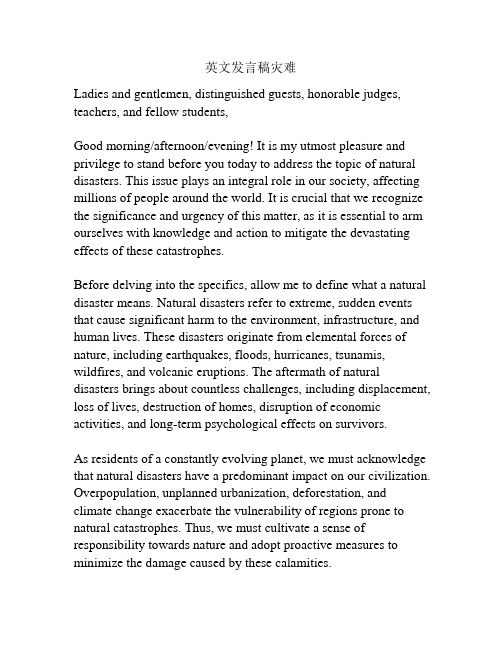
英文发言稿灾难Ladies and gentlemen, distinguished guests, honorable judges, teachers, and fellow students,Good morning/afternoon/evening! It is my utmost pleasure and privilege to stand before you today to address the topic of natural disasters. This issue plays an integral role in our society, affecting millions of people around the world. It is crucial that we recognize the significance and urgency of this matter, as it is essential to arm ourselves with knowledge and action to mitigate the devastating effects of these catastrophes.Before delving into the specifics, allow me to define what a natural disaster means. Natural disasters refer to extreme, sudden events that cause significant harm to the environment, infrastructure, and human lives. These disasters originate from elemental forces of nature, including earthquakes, floods, hurricanes, tsunamis, wildfires, and volcanic eruptions. The aftermath of natural disasters brings about countless challenges, including displacement, loss of lives, destruction of homes, disruption of economic activities, and long-term psychological effects on survivors.As residents of a constantly evolving planet, we must acknowledge that natural disasters have a predominant impact on our civilization. Overpopulation, unplanned urbanization, deforestation, and climate change exacerbate the vulnerability of regions prone to natural catastrophes. Thus, we must cultivate a sense of responsibility towards nature and adopt proactive measures to minimize the damage caused by these calamities.The first step in mitigating the effects of natural disasters lies in understanding and preparing for them. Education and awareness play a vital role in equipping communities with the necessary knowledge and skills to respond effectively. Governments, in collaboration with non-governmental organizations and educational institutions, should prioritize disaster preparedness programs. These programs should focus on educating citizens about early warning systems, evacuation routes, emergency shelters, and first aid techniques. By instilling a culture of preparedness, we can ensure that communities are equipped to face the challenges posed by natural disasters.In addition to education, investing in advanced technology and infrastructure is essential in disaster response and recovery efforts. Governments must allocate adequate resources to develop and maintain early warning systems, satellite monitoring, and improved infrastructure that can withstand the impact of natural disasters. For example, constructing earthquake-resistant buildings in seismic zones, reinforcing flood defenses, and creating firebreaks in wildfire-prone regions are crucial steps towards minimizing the effects of disasters.Furthermore, collaboration and international cooperation are key aspects of disaster management. In today's interconnected world, no country can confront natural disasters alone. Governments should establish networks and share information, resources, and expertise to respond effectively to natural disasters. Regional cooperation can also be instrumental in providing aid to countries that lack the necessary resources and expertise to manage disasters on their own.Nonetheless, the aftermath of natural disasters exposes the fragile nature of societal structures, emphasizing the need for humanitarian assistance. Extending support and relief to affected communities demonstrates compassion and solidarity. Here, civil society organizations, community groups, and individuals can play a significant role in providing immediate and long-term assistance, including food, shelter, medical aid, and psychological support. The power of a helping hand should never be underestimated, as it can rebuild lives and restore hope for a brighter future.Lastly, the significance of long-term planning and prevention cannot be overstated. Governments and stakeholders must prioritize sustainable development policies that address the root causes of natural disasters. Implementing measures to reduce greenhouse gas emissions, protecting natural habitats, enforcing building codes, and promoting climate change adaptation strategies are integral steps towards building a resilient society that can withstand the impacts of inevitable natural disasters.In conclusion, natural disasters are inevitable events that have the potential to wreak havoc on human lives, infrastructure, and the environment. By educating ourselves, preparing communities, investing in technology and infrastructure, fostering international cooperation, extending humanitarian assistance, and practicing long-term planning and prevention, we can minimize the devastating effects of natural disasters. Let us remember that our actions today will directly impact the lives of future generations, and it is our duty to leave behind a world that is better equipped and prepared to face the challenges posed by these calamities.Thank you for your attention.。
人为灾害作文英文初中
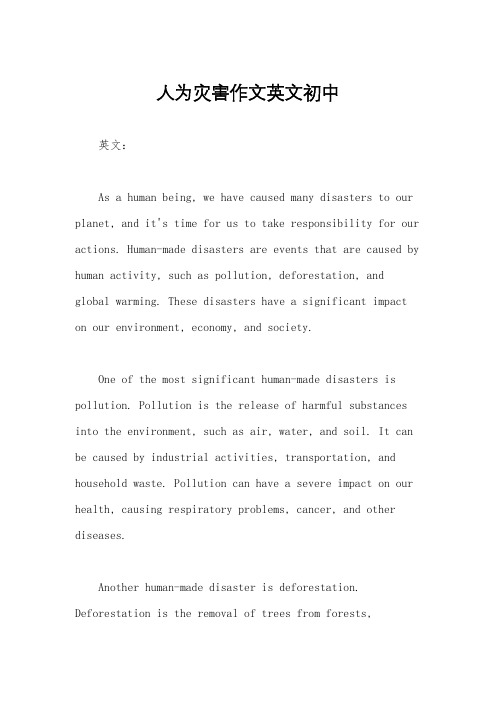
人为灾害作文英文初中英文:As a human being, we have caused many disasters to our planet, and it's time for us to take responsibility for our actions. Human-made disasters are events that are caused by human activity, such as pollution, deforestation, and global warming. These disasters have a significant impact on our environment, economy, and society.One of the most significant human-made disasters is pollution. Pollution is the release of harmful substances into the environment, such as air, water, and soil. It can be caused by industrial activities, transportation, and household waste. Pollution can have a severe impact on our health, causing respiratory problems, cancer, and other diseases.Another human-made disaster is deforestation. Deforestation is the removal of trees from forests,primarily for commercial purposes. It can lead to soil erosion, loss of biodiversity, and climate change. Deforestation has a significant impact on our environment, as it affects the water cycle, soil quality, and air quality.Global warming is also a human-made disaster that is caused by the emission of greenhouse gases, such as carbon dioxide, into the atmosphere. These gases trap heat, causing the Earth's temperature to rise. Global warming can lead to severe weather conditions, such as hurricanes, floods, and droughts, which can have a significant impact on our economy and society.As a society, we need to take responsibility for our actions and work towards reducing human-made disasters. We can do this by reducing our carbon footprint, recycling, using public transportation, and supporting sustainable practices. It's time for us to take action and protect our planet for future generations.中文:作为人类,我们对我们的星球造成了许多灾难,现在是我们承担责任的时候了。
人为灾害英语讲稿
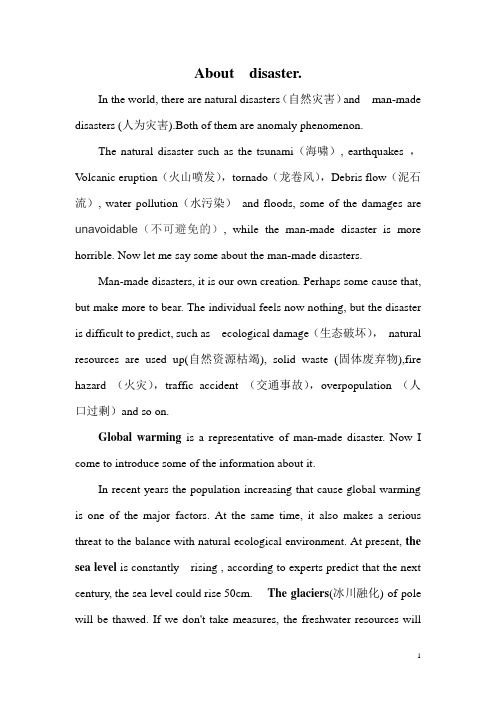
About disaster.In the world, there are natural disasters(自然灾害)and man-made disasters (人为灾害).Both of them are anomaly phenomenon.The natural disaster such as the tsunami(海啸), earthquakes ,V olcanic eruption(火山喷发),tornado(龙卷风),Debris flow(泥石流), water pollution(水污染)and floods, some of the damages are unavoidable(不可避免的), while the man-made disaster is more horrible. Now let me say some about the man-made disasters.Man-made disasters, it is our own creation. Perhaps some cause that, but make more to bear. The individual feels now nothing, but the disaster is difficult to predict, such as ecological damage(生态破坏),natural resources are used up(自然资源枯竭), solid waste (固体废弃物),fire hazard (火灾),traffic accident (交通事故),overpopulation (人口过剩)and so on.Global warming is a representative of man-made disaster. Now I come to introduce some of the information about it.In recent years the population increasing that cause global warming is one of the major factors. At the same time, it also makes a serious threat to the balance with natural ecological environment. At present, the sea level is constantly rising , according to experts predict that the next century, the sea level could rise 50cm. The glaciers(冰川融化)of pole will be thawed. If we don't take measures, the freshwater resources willdirectly cause the destruction and pollution. The fundamental method is to reduce carbon emissions, such as reducing population(减少人口), reducing fossil fuels( coal, oil and gas, etc.减少化石燃料), using more new energy (light and water, wind,使用新能源etc), more creature planting green plants绿色植物to absorb carbon and give off oxygen to improve the condition.Since they are man-made disasters, I think we should solve that from the start. The earth is our only home-planet. It is urgent for us to stop damaging it, and to do our best to protect it and make it a lovely place suitable to live in.Let us make a little contribution to the society,and making our motherland more beautiful.。
灾害防范英语演讲稿范文
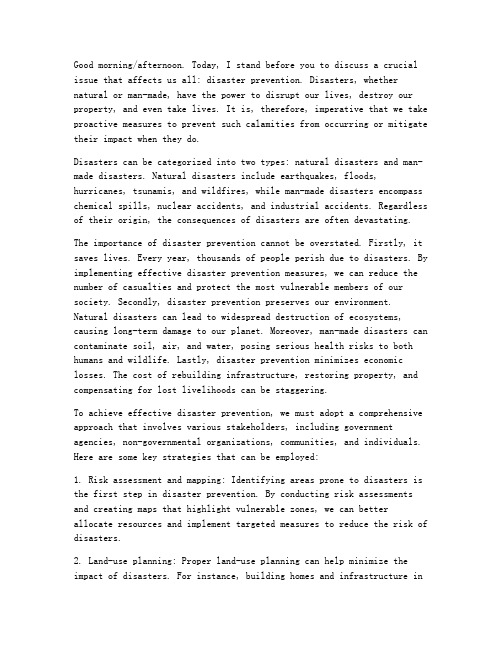
Good morning/afternoon. Today, I stand before you to discuss a crucial issue that affects us all: disaster prevention. Disasters, whether natural or man-made, have the power to disrupt our lives, destroy our property, and even take lives. It is, therefore, imperative that we take proactive measures to prevent such calamities from occurring or mitigate their impact when they do.Disasters can be categorized into two types: natural disasters and man-made disasters. Natural disasters include earthquakes, floods, hurricanes, tsunamis, and wildfires, while man-made disasters encompass chemical spills, nuclear accidents, and industrial accidents. Regardless of their origin, the consequences of disasters are often devastating.The importance of disaster prevention cannot be overstated. Firstly, it saves lives. Every year, thousands of people perish due to disasters. By implementing effective disaster prevention measures, we can reduce the number of casualties and protect the most vulnerable members of our society. Secondly, disaster prevention preserves our environment. Natural disasters can lead to widespread destruction of ecosystems, causing long-term damage to our planet. Moreover, man-made disasters can contaminate soil, air, and water, posing serious health risks to both humans and wildlife. Lastly, disaster prevention minimizes economic losses. The cost of rebuilding infrastructure, restoring property, and compensating for lost livelihoods can be staggering.To achieve effective disaster prevention, we must adopt a comprehensive approach that involves various stakeholders, including government agencies, non-governmental organizations, communities, and individuals. Here are some key strategies that can be employed:1. Risk assessment and mapping: Identifying areas prone to disasters is the first step in disaster prevention. By conducting risk assessments and creating maps that highlight vulnerable zones, we can betterallocate resources and implement targeted measures to reduce the risk of disasters.2. Land-use planning: Proper land-use planning can help minimize the impact of disasters. For instance, building homes and infrastructure inhigh-risk areas, such as floodplains or earthquake-prone zones, should be avoided. Additionally, creating green spaces and preserving natural buffers can act as barriers against natural disasters.3. Early warning systems: Developing and maintaining early warning systems is crucial for disaster prevention. These systems can provide timely alerts to the public, enabling them to take necessary precautions and evacuate if needed. Investing in technology, such as satellite imagery and seismological monitoring, can enhance the accuracy and reliability of early warning systems.4. Public awareness and education: Educating the public about the risks of disasters and the necessary precautions to take is essential. This includes disseminating information about emergency response procedures, first aid training, and the importance of having an emergency kit. Schools, community centers, and workplaces should all be involved in promoting disaster preparedness.5. Emergency response planning: Governments and organizations should develop comprehensive emergency response plans that outline the steps to be taken during a disaster. This includes coordinating with various agencies, such as fire departments, police, and medical services, to ensure an efficient and coordinated response.6. Infrastructure resilience: Investing in resilient infrastructure can reduce the impact of disasters. This includes constructing buildings and roads that can withstand extreme weather conditions, improving drainage systems to prevent flooding, and ensuring that critical infrastructure, such as hospitals and power plants, can continue to function during a disaster.7. International cooperation: Disasters do not recognize national boundaries. Therefore, international cooperation is vital in sharing knowledge, resources, and best practices in disaster prevention. This includes participating in regional and global initiatives aimed at reducing disaster risks and promoting disaster resilience.In conclusion, disaster prevention is a crucial responsibility that we must all undertake. By adopting a comprehensive approach, we can reduce the risk of disasters, protect lives and property, and safeguard our environment. Let us work together to create a safer and more resilient future for ourselves and future generations.Thank you.。
呼吁所有人注意人为自然灾害英语作文
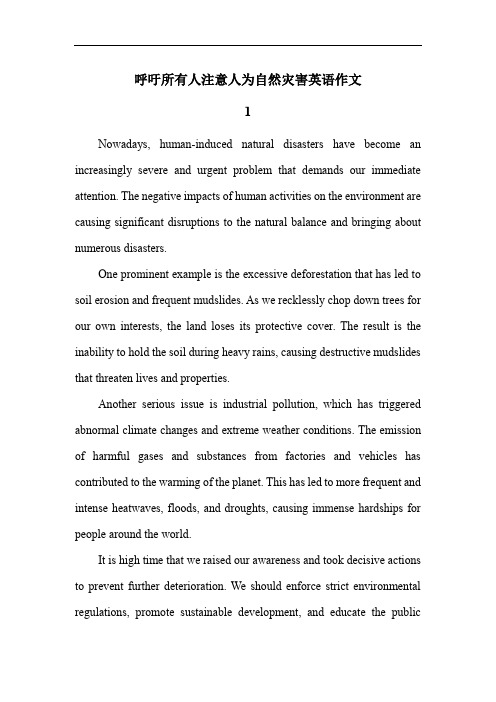
呼吁所有人注意人为自然灾害英语作文1Nowadays, human-induced natural disasters have become an increasingly severe and urgent problem that demands our immediate attention. The negative impacts of human activities on the environment are causing significant disruptions to the natural balance and bringing about numerous disasters.One prominent example is the excessive deforestation that has led to soil erosion and frequent mudslides. As we recklessly chop down trees for our own interests, the land loses its protective cover. The result is the inability to hold the soil during heavy rains, causing destructive mudslides that threaten lives and properties.Another serious issue is industrial pollution, which has triggered abnormal climate changes and extreme weather conditions. The emission of harmful gases and substances from factories and vehicles has contributed to the warming of the planet. This has led to more frequent and intense heatwaves, floods, and droughts, causing immense hardships for people around the world.It is high time that we raised our awareness and took decisive actions to prevent further deterioration. We should enforce strict environmental regulations, promote sustainable development, and educate the publicabout the importance of protecting our environment. Only by working together can we mitigate the severity of human-induced natural disasters and ensure a sustainable future for generations to come. Let us act now before it is too late.2Human activities have increasingly led to various natural disasters, and it is high time that we all paid close attention to this issue. The causes and harms of man-made natural disasters are deeply rooted and wide-ranging.Take the rapid urbanization process as an example. Unreasonable planning often results in flood disasters. Cities expand rapidly without proper consideration of drainage systems, and when heavy rains come, water accumulates, causing significant damage to property and threatening people's lives.Another prominent issue is the random disposal of waste. The unrestrained discharge of industrial and domestic waste disrupts the ecological balance. This disruption leads to a series of problems such as soil erosion, water pollution, and the outbreak of diseases. For instance, excessive chemical waste in water bodies can kill aquatic life and ultimately affect the entire ecosystem.These man-made natural disasters not only cause immediate losses but also have long-term negative impacts. They undermine the stability andsustainability of our living environment, making our future full of uncertainties.Therefore, it is the responsibility of each of us to take action. We should raise awareness, promote scientific planning in urban development, and implement strict waste management regulations. Only by doing so can we minimize the occurrence of man-made natural disasters and ensure a better future for ourselves and future generations.3Nowadays, human-induced natural disasters have become an increasingly serious problem that demands our urgent attention. It is astonishing to note that each year, these disasters caused by human activities result in colossal economic losses and a heartbreaking number of casualties.For instance, deforestation leads to soil erosion and frequent floods, which not only destroy countless homes but also disrupt people's lives and cause significant economic setbacks. The excessive emission of greenhouse gases contributes to global warming, triggering more extreme weather conditions like heatwaves and droughts. These disasters inflict immense damage on agriculture and infrastructure, with the economic losses running into billions of dollars.However, there are also positive examples where effective measures have been taken to mitigate the occurrence of such disasters. In someregions, strict environmental regulations and reforestation efforts have successfully reduced the frequency and severity of floods. The implementation of sustainable energy policies has curbed the emission of harmful gases, improving the climate and minimizing the risks of related disasters.We must all recognize that the power to prevent these disasters lies in our hands. It is our responsibility to take action and make a change. We should adopt eco-friendly lifestyles, support green technologies, and advocate for stronger environmental protection laws. Only through our collective efforts can we hope to build a safer and more sustainable world for future generations. Let us act now before it is too late.4In today's world, man-made natural disasters have become a serious global issue that demands our immediate attention and collective efforts. These disasters are not only causing immense damage to our environment but also threatening the very existence of humanity.Take the example of transboundary pollution. Industries in one country may release harmful substances that spread across borders, affecting the air, water, and soil of neighboring nations. This leads to a chain reaction of ecological imbalance and poses risks to the health and livelihoods of people in multiple regions.Another significant concern is climate change. It is a global challengethat requires joint actions from all countries. The excessive emission of greenhouse gases has led to rising temperatures, melting glaciers, and more frequent extreme weather events such as floods, droughts, and heatwaves. These disasters do not respect national boundaries and have a far-reaching impact on the entire planet.It is evident that man-made natural disasters are not isolated incidents but rather interconnected problems that require international cooperation. We need to share knowledge and technology, establish common policies and regulations, and work together to reduce pollution and mitigate the effects of climate change.Only through global unity and determined efforts can we hope to effectively address these pressing issues and safeguard our planet for future generations. Let us come together and take decisive action now, before it is too late.5In recent years, the issue of man-made natural disasters has become increasingly prominent and demands our immediate attention. Scientific research has revealed alarming connections between human activities and the escalating frequency and severity of natural calamities.Recent studies have shown that deforestation, for instance, not only disrupts the ecological balance but also contributes significantly to soil erosion and increased flood risks. Moreover, the excessive emission ofgreenhouse gases due to industrial activities has led to global warming, resulting in more extreme weather conditions such as heatwaves, droughts, and powerful storms.Expert predictions for the future are equally disturbing. They anticipate that if we continue on this unsustainable path, the frequency and intensity of man-made disasters will multiply exponentially. This could potentially lead to widespread food shortages, mass migrations, and even threaten the very existence of some communities.It is high time that we recognized the gravity of the situation and took collective and decisive action. We must enforce strict environmental regulations, promote sustainable energy sources, and raise public awareness about the importance of environmental conservation. Only through our concerted efforts can we hope to mitigate the threat of man-made natural disasters and secure a sustainable future for generations to come. Let us act now before it is too late.。
人为灾害作文英文
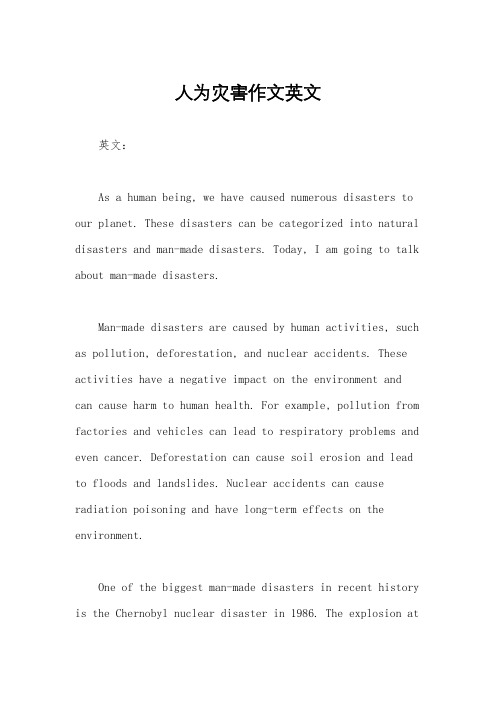
人为灾害作文英文英文:As a human being, we have caused numerous disasters to our planet. These disasters can be categorized into natural disasters and man-made disasters. Today, I am going to talk about man-made disasters.Man-made disasters are caused by human activities, such as pollution, deforestation, and nuclear accidents. These activities have a negative impact on the environment and can cause harm to human health. For example, pollution from factories and vehicles can lead to respiratory problems and even cancer. Deforestation can cause soil erosion and lead to floods and landslides. Nuclear accidents can cause radiation poisoning and have long-term effects on the environment.One of the biggest man-made disasters in recent history is the Chernobyl nuclear disaster in 1986. The explosion atthe nuclear power plant caused a massive release of radioactive material into the environment. The disaster had a devastating impact on the health of the local population and the environment. Even today, over 30 years later, the area around the Chernobyl power plant is still uninhabitable.Another example of man-made disasters is the Great Pacific Garbage Patch. This is a massive collection of plastic waste in the Pacific Ocean, caused by humanactivities such as littering and improper disposal ofplastic products. The garbage patch is estimated to betwice the size of Texas and is having a negative impact on marine life and the environment.In conclusion, man-made disasters are a serious threatto our planet and our health. We need to takeresponsibility for our actions and make changes to reduce our impact on the environment. This can include reducingour use of plastic products, using renewable energy sources, and implementing stricter regulations on pollution.中文:作为人类,我们已经给我们的星球带来了无数的灾难。
洪灾报道英语演讲稿范文
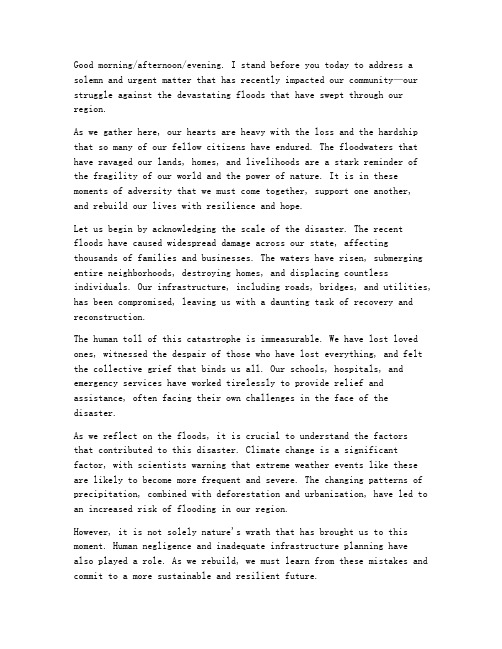
Good morning/afternoon/evening. I stand before you today to address a solemn and urgent matter that has recently impacted our community—our struggle against the devastating floods that have swept through our region.As we gather here, our hearts are heavy with the loss and the hardship that so many of our fellow citizens have endured. The floodwaters that have ravaged our lands, homes, and livelihoods are a stark reminder of the fragility of our world and the power of nature. It is in these moments of adversity that we must come together, support one another,and rebuild our lives with resilience and hope.Let us begin by acknowledging the scale of the disaster. The recent floods have caused widespread damage across our state, affecting thousands of families and businesses. The waters have risen, submerging entire neighborhoods, destroying homes, and displacing countless individuals. Our infrastructure, including roads, bridges, and utilities, has been compromised, leaving us with a daunting task of recovery and reconstruction.The human toll of this catastrophe is immeasurable. We have lost loved ones, witnessed the despair of those who have lost everything, and felt the collective grief that binds us all. Our schools, hospitals, and emergency services have worked tirelessly to provide relief and assistance, often facing their own challenges in the face of the disaster.As we reflect on the floods, it is crucial to understand the factorsthat contributed to this disaster. Climate change is a significant factor, with scientists warning that extreme weather events like these are likely to become more frequent and severe. The changing patterns of precipitation, combined with deforestation and urbanization, have led to an increased risk of flooding in our region.However, it is not solely nature's wrath that has brought us to this moment. Human negligence and inadequate infrastructure planning havealso played a role. As we rebuild, we must learn from these mistakes and commit to a more sustainable and resilient future.In the aftermath of the floods, our first priority must be to provide immediate relief to those in need. This includes ensuring that families have access to food, shelter, and medical care. The government, non-governmental organizations, and private sector must work together to coordinate efforts and deliver aid efficiently.The long-term recovery process will require a comprehensive approach. We must prioritize the reconstruction of critical infrastructure, including homes, schools, and healthcare facilities. It is essential to invest in flood defenses, such as levees and stormwater management systems, to protect our communities from future disasters.Furthermore, we must focus on strengthening our community resilience. This involves raising awareness about flood risks, implementing early warning systems, and training our citizens in emergency preparedness. By empowering our people to take proactive measures, we can minimize the impact of future floods.In our efforts to rebuild, we must also address the socio-economic implications of the disaster. The floods have not only destroyed physical assets but have also disrupted the livelihoods of many. We must provide support to businesses, farmers, and workers affected by the disaster, ensuring that they have the resources to recover and thrive.Ladies and gentlemen, the road to recovery will be long and challenging. However, it is a journey that we must undertake together, hand in hand. Our unity and solidarity will be our greatest strength in overcomingthis adversity.As we rebuild, let us remember the lessons learned from this disaster. Let us invest in sustainable practices that protect our environment and reduce the risk of future floods. Let us foster a culture of preparedness and resilience, ensuring that our communities are better equipped to face the challenges of the future.In conclusion, the recent floods have brought immense pain and suffering to our region. However, they have also awakened a collective spirit of determination and hope. With our unwavering commitment to rebuild, wecan transform this tragedy into an opportunity for a stronger, more resilient, and sustainable future.Thank you for your attention and support. Together, we shall rise above the floods and emerge as a more united and resilient community.God bless our efforts, and God bless our beloved country.Thank you.。
以灾难为话题的英语演讲稿
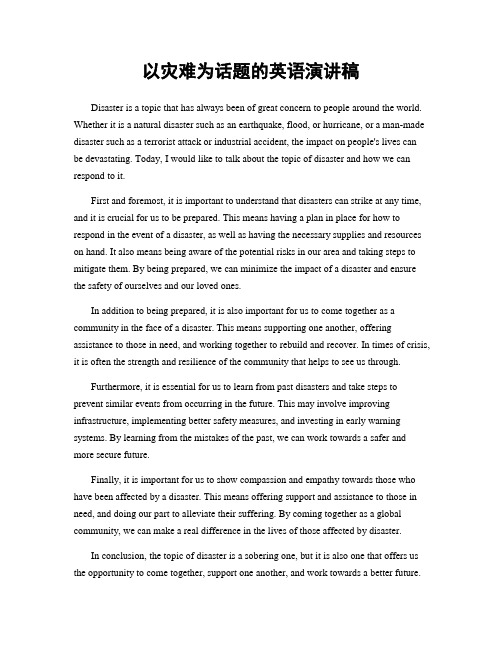
以灾难为话题的英语演讲稿Disaster is a topic that has always been of great concern to people around the world. Whether it is a natural disaster such as an earthquake, flood, or hurricane, or a man-made disaster such as a terrorist attack or industrial accident, the impact on people's lives can be devastating. Today, I would like to talk about the topic of disaster and how we can respond to it.First and foremost, it is important to understand that disasters can strike at any time, and it is crucial for us to be prepared. This means having a plan in place for how to respond in the event of a disaster, as well as having the necessary supplies and resources on hand. It also means being aware of the potential risks in our area and taking steps to mitigate them. By being prepared, we can minimize the impact of a disaster and ensure the safety of ourselves and our loved ones.In addition to being prepared, it is also important for us to come together as a community in the face of a disaster. This means supporting one another, offering assistance to those in need, and working together to rebuild and recover. In times of crisis, it is often the strength and resilience of the community that helps to see us through.Furthermore, it is essential for us to learn from past disasters and take steps to prevent similar events from occurring in the future. This may involve improving infrastructure, implementing better safety measures, and investing in early warning systems. By learning from the mistakes of the past, we can work towards a safer and more secure future.Finally, it is important for us to show compassion and empathy towards those who have been affected by a disaster. This means offering support and assistance to those in need, and doing our part to alleviate their suffering. By coming together as a global community, we can make a real difference in the lives of those affected by disaster.In conclusion, the topic of disaster is a sobering one, but it is also one that offers us the opportunity to come together, support one another, and work towards a better future.By being prepared, coming together as a community, learning from the past, and showing compassion, we can respond to disasters in a way that helps to minimize their impact and build a stronger, more resilient world. Thank you.。
呼吁所有人注意人为自然灾害书信英语作文
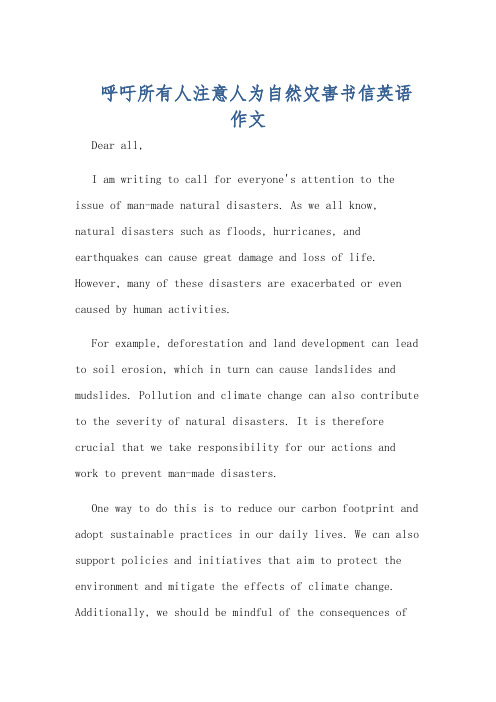
呼吁所有人注意人为自然灾害书信英语作文Dear all,I am writing to call for everyone's attention to the issue of man-made natural disasters. As we all know, natural disasters such as floods, hurricanes, and earthquakes can cause great damage and loss of life. However, many of these disasters are exacerbated or even caused by human activities.For example, deforestation and land development can lead to soil erosion, which in turn can cause landslides and mudslides. Pollution and climate change can also contribute to the severity of natural disasters. It is therefore crucial that we take responsibility for our actions and work to prevent man-made disasters.One way to do this is to reduce our carbon footprint and adopt sustainable practices in our daily lives. We can also support policies and initiatives that aim to protect the environment and mitigate the effects of climate change. Additionally, we should be mindful of the consequences ofour actions and avoid activities that may harm the environment or put ourselves and others at risk.In conclusion, it is time for us to recognize the impact of human activities on the natural world and take action to prevent man-made disasters. Let us work together to createa safer and more sustainable future for ourselves and for generations to come.中文翻译:亲爱的大家,我写信呼吁所有人注意人为自然灾害的问题。
呼吁大家保护人为灾害的英语作文
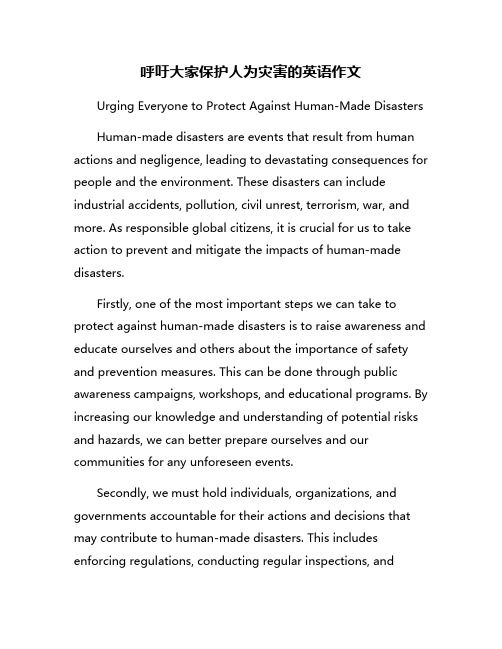
呼吁大家保护人为灾害的英语作文Urging Everyone to Protect Against Human-Made DisastersHuman-made disasters are events that result from human actions and negligence, leading to devastating consequences for people and the environment. These disasters can include industrial accidents, pollution, civil unrest, terrorism, war, and more. As responsible global citizens, it is crucial for us to take action to prevent and mitigate the impacts of human-made disasters.Firstly, one of the most important steps we can take to protect against human-made disasters is to raise awareness and educate ourselves and others about the importance of safety and prevention measures. This can be done through public awareness campaigns, workshops, and educational programs. By increasing our knowledge and understanding of potential risks and hazards, we can better prepare ourselves and our communities for any unforeseen events.Secondly, we must hold individuals, organizations, and governments accountable for their actions and decisions that may contribute to human-made disasters. This includes enforcing regulations, conducting regular inspections, andimplementing strict protocols to ensure the safety andwell-being of all citizens. By holding those responsible for their actions, we can prevent future disasters from occurring and create a safer environment for everyone.In addition, it is crucial for us to advocate for sustainable practices and policies that reduce our impact on the environment and minimize the risks of human-made disasters. This includes promoting renewable energy sources, reducing carbon emissions, and implementing waste management strategies that protect our natural resources and ecosystems. By adopting sustainable practices, we can create a more resilient and environmentally friendly society that is better equipped to withstand and recover from human-made disasters.Furthermore, we must also prioritize emergency preparedness and response efforts to ensure that we are ready to act quickly and effectively in the event of a human-made disaster. This includes developing emergency plans, conducting drills and exercises, and establishing communication networks to coordinate response efforts. By being prepared and organized, we can minimize the impacts of disasters and save lives in times of crisis.Ultimately, protecting against human-made disasters requires a collective effort from all individuals, communities, and governments. By working together and taking proactive steps to prevent and mitigate the impacts of human-made disasters, we can create a safer and more sustainable world for future generations. It is our responsibility to take action now and prioritize the protection of our planet and its inhabitants. Let us all join hands and commit to safeguarding against human-made disasters for a better and brighter future.。
人为的灾害作文英文
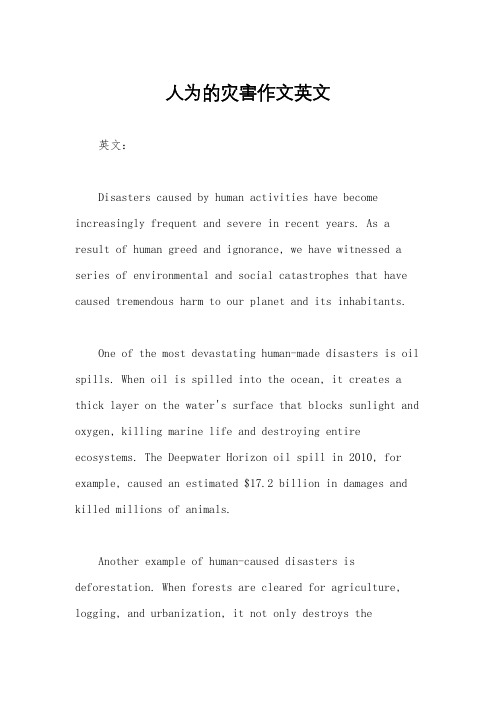
人为的灾害作文英文英文:Disasters caused by human activities have become increasingly frequent and severe in recent years. As a result of human greed and ignorance, we have witnessed a series of environmental and social catastrophes that have caused tremendous harm to our planet and its inhabitants.One of the most devastating human-made disasters is oil spills. When oil is spilled into the ocean, it creates a thick layer on the water's surface that blocks sunlight and oxygen, killing marine life and destroying entire ecosystems. The Deepwater Horizon oil spill in 2010, for example, caused an estimated $17.2 billion in damages and killed millions of animals.Another example of human-caused disasters is deforestation. When forests are cleared for agriculture, logging, and urbanization, it not only destroys thehabitats of countless species but also contributes to climate change. Deforestation releases carbon dioxide into the atmosphere, which contributes to global warming and exacerbates natural disasters such as floods, droughts, and wildfires.In addition to these environmental disasters, human activities have also caused social and economic disasters. For example, the exploitation of workers in sweatshops and factories has led to numerous tragedies, such as the collapse of the Rana Plaza factory in Bangladesh in 2013, which killed over 1,100 people. The use of child labor and the violation of workers' rights in many industries have also caused immense suffering and injustice.Overall, human-made disasters are a serious threat to our planet and its inhabitants. It is crucial that we take responsibility for our actions and work together to prevent and mitigate these disasters. We must prioritize sustainability and social justice in all our decisions and actions, and hold corporations and governments accountable for their impact on the environment and society.中文:由人类活动引起的灾难在近年来变得越来越频繁和严重。
抗洪英语演讲稿三分钟(3篇)
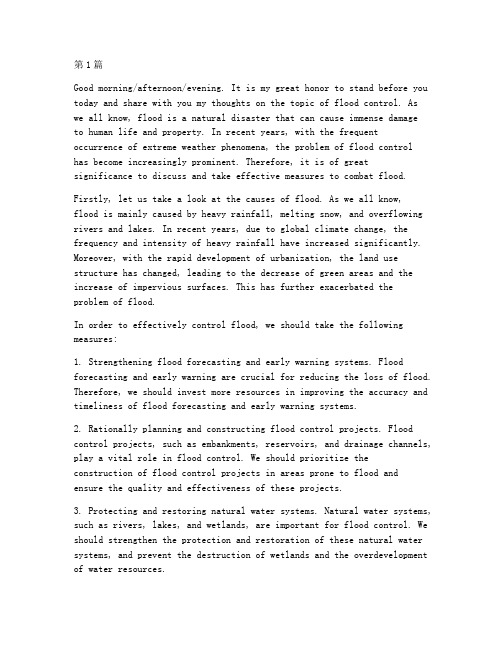
第1篇Good morning/afternoon/evening. It is my great honor to stand before you today and share with you my thoughts on the topic of flood control. As we all know, flood is a natural disaster that can cause immense damageto human life and property. In recent years, with the frequent occurrence of extreme weather phenomena, the problem of flood controlhas become increasingly prominent. Therefore, it is of greatsignificance to discuss and take effective measures to combat flood.Firstly, let us take a look at the causes of flood. As we all know,flood is mainly caused by heavy rainfall, melting snow, and overflowing rivers and lakes. In recent years, due to global climate change, the frequency and intensity of heavy rainfall have increased significantly. Moreover, with the rapid development of urbanization, the land use structure has changed, leading to the decrease of green areas and the increase of impervious surfaces. This has further exacerbated the problem of flood.In order to effectively control flood, we should take the following measures:1. Strengthening flood forecasting and early warning systems. Flood forecasting and early warning are crucial for reducing the loss of flood. Therefore, we should invest more resources in improving the accuracy and timeliness of flood forecasting and early warning systems.2. Rationally planning and constructing flood control projects. Flood control projects, such as embankments, reservoirs, and drainage channels, play a vital role in flood control. We should prioritize theconstruction of flood control projects in areas prone to flood andensure the quality and effectiveness of these projects.3. Protecting and restoring natural water systems. Natural water systems, such as rivers, lakes, and wetlands, are important for flood control. We should strengthen the protection and restoration of these natural water systems, and prevent the destruction of wetlands and the overdevelopment of water resources.4. Promoting the concept of green development. Green development is an important strategy for flood control. We should encourage the development of green industries, promote the construction of green cities, and reduce the impact of human activities on the natural water systems.5. Raising public awareness and enhancing emergency response. Flood control is a joint effort of the whole society. We should strengthen public education on flood control, raise people's awareness of flood risks, and improve the emergency response capabilities of governments and communities.6. Implementing strict water resource management. Water resources are the basis for flood control. We should implement strict water resource management policies, promote the reasonable allocation and utilization of water resources, and reduce the risk of flood caused by water shortage or excessive water.In conclusion, flood control is a long-term and arduous task. We should adhere to the people-centered philosophy, implement the above measures, and work together to achieve the goal of flood control. Only by doing so can we protect our lives and property, ensure the sustainable development of society, and create a better living environment forfuture generations.Thank you for your attention.第2篇Good morning/afternoon/evening. It is with a heavy heart and a sense of urgency that I stand before you today to address the issue of flood disasters that have recently affected numerous communities around the world. As we gather here, many are still reeling from the aftermath of these devastating floods, which have not only caused loss of life but also immense destruction to homes, infrastructure, and the environment.The recent floods serve as a stark reminder of the fragility of our planet and the urgent need for collective action to mitigate the impacts of such natural disasters. In this speech, I will discuss the causes offloods, the devastating effects they have on societies, and the steps we can take to prevent future disasters.The Causes of FloodsFloods occur when an overflow of water submerges land that is usually dry. There are several factors that contribute to the occurrence of floods:1. Excessive Rainfall: Heavy rainfall over a short period can overwhelm rivers, lakes, and other bodies of water, causing them to overflow their banks.2. Melting Ice and Snow: In regions where snow and ice are prevalent, rapid melting can lead to increased runoff, contributing to flooding.3. Deforestation: The removal of trees can lead to soil erosion, reducing the land's ability to absorb water and causing runoff.4. Urbanization: Rapid urban development often leads to the paving over of natural landscapes, which decreases the land's capacity to absorb water.5. Climate Change: The changing climate patterns are leading to more extreme weather events, including heavier rainfall and more intense storms, which increase the risk of flooding.The Devastating Effects of FloodsThe impact of floods is profound and far-reaching. Here are some of the ways in which floods can devastate communities:1. Loss of Life and Injury: Floods can lead to drowning, as well as injury from debris and contaminated water.2. Economic Loss: The destruction of homes, businesses, and infrastructure can lead to significant economic losses, impacting the livelihoods of countless individuals.3. Health Risks: Floodwater can carry diseases, and the disruption of sanitation services can lead to outbreaks of waterborne illnesses.4. Psychological Trauma: The trauma of losing one's home and belongings, witnessing the destruction of communities, and the loss of loved onescan have long-lasting psychological effects.5. Environmental Damage: Floods can disrupt ecosystems, leading to the loss of biodiversity and the degradation of natural habitats.Preventing Future DisastersTo prevent future floods and mitigate their impact, we must take immediate and sustained action:1. Invest in Infrastructure: Upgrading and maintaining our water management systems is crucial. This includes building and improvingflood defenses, such as levees and flood barriers.2. Enhance Preparedness: Governments and communities must develop and implement comprehensive flood preparedness plans, including earlywarning systems and evacuation procedures.3. Promote Sustainable Practices: Encouraging sustainable land use, such as reforestation and the protection of wetlands, can help to reduce the risk of flooding.4. Foster International Cooperation: Given the global nature of climate change, international collaboration is essential. We must share knowledge, resources, and best practices to address the challenges posed by floods.5. Education and Awareness: Raising public awareness about flood risks and the importance of preparedness can empower individuals and communities to take action.In conclusion, floods are a tragic reality that we must confront head-on. The recent floods have shown us the devastating consequences of inaction. It is time for us to unite and take bold steps to protect our planet and our fellow human beings. By investing in infrastructure, enhancing preparedness, promoting sustainable practices, fostering international cooperation, and educating our communities, we can reduce the risk of future floods and build more resilient societies.Thank you for your attention. Let us work together to ensure a safer, more secure future for all.[End of speech]第3篇Today, I stand before you to address a topic that touches the hearts of every citizen in our beloved country - the relentless battle against floods. As we gather here today, we are reminded of the fierce floods that have ravaged our lands, displacing countless families, destroying properties, and disrupting the normalcy of our lives. However, amidst the chaos and despair, we find strength, resilience, and unity.Firstly, let us acknowledge the severity of the flood situation. In recent years, our country has witnessed unprecedented floods, with devastating consequences. The overflowing rivers, the relentless rain, and the relentless winds have caused immense damage to our infrastructure, agriculture, and economy. Lives have been lost, homes have been destroyed, and communities have been torn apart. The scale of destruction is immense, and the road to recovery is long and arduous.However, amidst the darkness, we see the light of hope. The spirit of our people is unbreakable, and we have witnessed countless acts of bravery and kindness during these challenging times. The floodwaters have brought out the best in us, reminding us of the strength that lies within each and every one of us.One of the key factors in our battle against floods is early warning systems. The timely dissemination of information can save countless lives and minimize the damage caused by floods. It is crucial that our government and relevant authorities invest in improving our early warning systems, ensuring that information reaches every corner of our country. This includes the installation of floodgates, the construction of dykes, and the deployment of flood forecasting technologies.Furthermore, we must prioritize disaster preparedness and emergency response. The government should establish comprehensive disaster management plans, ensuring that all stakeholders, including localgovernments, NGOs, and communities, are well-prepared to respond toflood situations. This includes the training of emergency response teams, the procurement of necessary equipment, and the establishment of evacuation centers.Another crucial aspect is the protection of vulnerable communities. We must recognize that certain areas are more prone to flooding, and it is our responsibility to protect the lives and properties of those residing in these areas. This involves the implementation of floodproofing measures, such as the construction of flood barriers and the relocation of vulnerable communities to safer locations.In addition to government efforts, it is essential for individuals and communities to take proactive steps in preventing and mitigating the impact of floods. This includes adopting sustainable land management practices, such as reforestation and soil conservation, which can help reduce soil erosion and improve water retention. It also involvesraising awareness about flood risks and promoting responsible behavior, such as not disposing of waste in stormwater drains.Furthermore, we must not underestimate the power of international cooperation. As a nation, we have the opportunity to learn from the experiences of other countries that have successfully combated floods.By sharing knowledge, resources, and best practices, we can enhance our own efforts and build a more resilient society.Lastly, let us not forget the importance of long-term planning and sustainable development. The relentless pursuit of economic growthshould not come at the expense of our environment. We must prioritize sustainable development, ensuring that our actions today do not compromise the well-being of future generations. This includes investing in green infrastructure, promoting renewable energy, and protecting our natural resources.In conclusion, the battle against floods is a daunting challenge, but it is one that we must face with unwavering determination. By implementing early warning systems, prioritizing disaster preparedness, protecting vulnerable communities, promoting sustainable practices, and fosteringinternational cooperation, we can build a more resilient society that can withstand the fury of nature.Ladies and gentlemen, let us come together, united in our resolve to protect our lands, our homes, and our loved ones. Let us not be deterred by the darkness, for it is in the face of adversity that we find our true strength. Together, we can overcome the floods and emerge stronger, more resilient, and more united than ever before.Thank you.。
人为灾害介绍英文作文
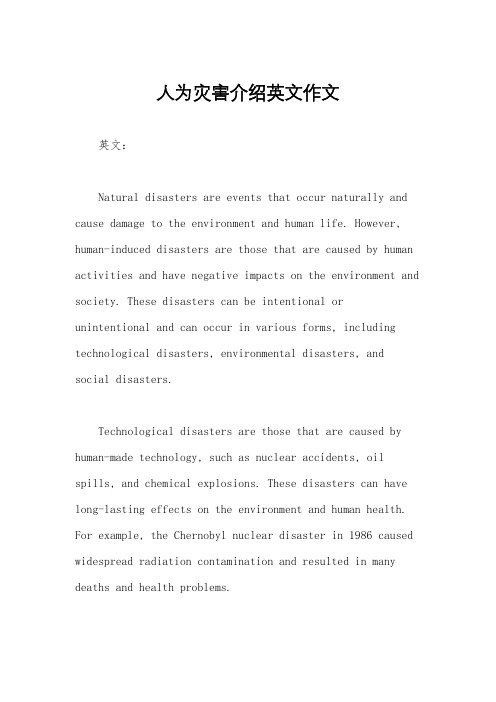
人为灾害介绍英文作文英文:Natural disasters are events that occur naturally and cause damage to the environment and human life. However, human-induced disasters are those that are caused by human activities and have negative impacts on the environment and society. These disasters can be intentional orunintentional and can occur in various forms, including technological disasters, environmental disasters, andsocial disasters.Technological disasters are those that are caused by human-made technology, such as nuclear accidents, oil spills, and chemical explosions. These disasters can have long-lasting effects on the environment and human health. For example, the Chernobyl nuclear disaster in 1986 caused widespread radiation contamination and resulted in many deaths and health problems.Environmental disasters are those that are caused by human activities that harm the natural environment, such as deforestation, pollution, and climate change. These disasters can have devastating effects on ecosystems and biodiversity. For example, the Amazon rainforest fires in 2019 were caused by human activities such as logging and farming, which led to the destruction of large areas of forest and the loss of many species.Social disasters are those that are caused by social factors such as poverty, inequality, and conflict. These disasters can have severe impacts on human life and well-being. For example, the Syrian refugee crisis was caused by a civil war that forced millions of people to flee their homes and seek refuge in other countries.中文:自然灾害是自然发生并对环境和人类生命造成破坏的事件。
人为灾害介绍英文作文
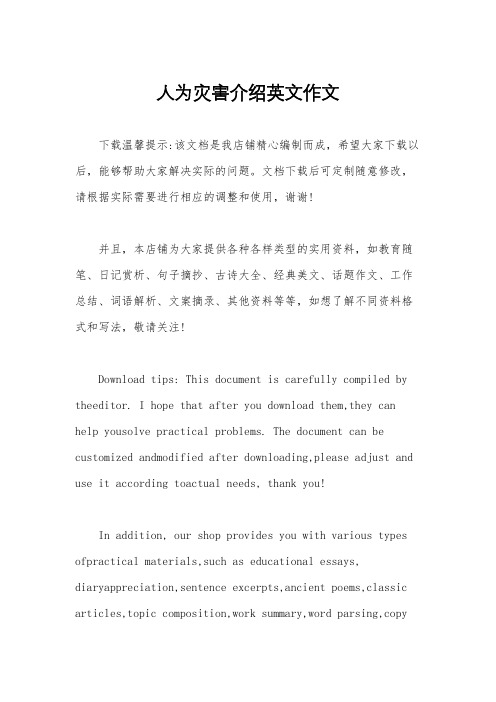
人为灾害介绍英文作文下载温馨提示:该文档是我店铺精心编制而成,希望大家下载以后,能够帮助大家解决实际的问题。
文档下载后可定制随意修改,请根据实际需要进行相应的调整和使用,谢谢!并且,本店铺为大家提供各种各样类型的实用资料,如教育随笔、日记赏析、句子摘抄、古诗大全、经典美文、话题作文、工作总结、词语解析、文案摘录、其他资料等等,如想了解不同资料格式和写法,敬请关注!Download tips: This document is carefully compiled by theeditor. I hope that after you download them,they can help yousolve practical problems. The document can be customized andmodified after downloading,please adjust and use it according toactual needs, thank you!In addition, our shop provides you with various types ofpractical materials,such as educational essays, diaryappreciation,sentence excerpts,ancient poems,classic articles,topic composition,work summary,word parsing,copyexcerpts,other materials and so on,want to know different data formats andwriting methods,please pay attention!Fires can be really terrifying. They can destroy homes and lives in an instant. And a lot of times, they're caused by human carelessness, like leaving a stove on or not putting out a cigarette properly.Earthquakes are another example. While they're natural disasters, the damage they cause can be made worse by poor building construction or not having proper emergency plans in place.Traffic accidents are a common human disaster. People driving too fast or not paying attention can lead to serious crashes that hurt or even kill people.Pollution is a slow-moving disaster. It messes up our environment and can cause all kinds of health problems for us and other living things.。
防灾救灾知识讲座英语作文
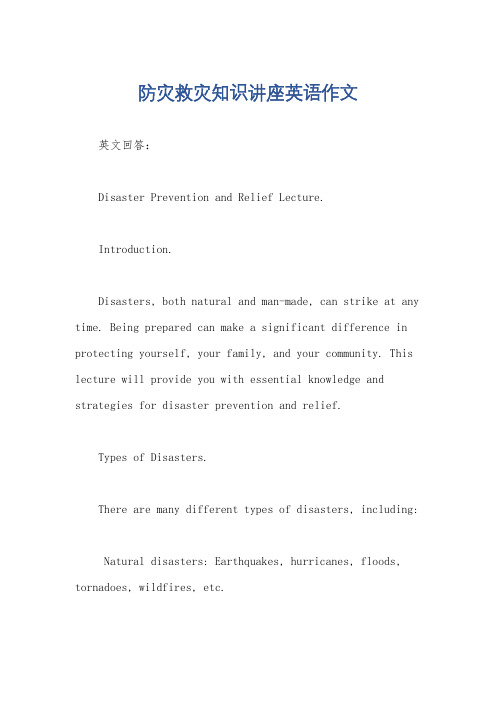
防灾救灾知识讲座英语作文英文回答:Disaster Prevention and Relief Lecture.Introduction.Disasters, both natural and man-made, can strike at any time. Being prepared can make a significant difference in protecting yourself, your family, and your community. This lecture will provide you with essential knowledge and strategies for disaster prevention and relief.Types of Disasters.There are many different types of disasters, including:Natural disasters: Earthquakes, hurricanes, floods, tornadoes, wildfires, etc.Man-made disasters: Industrial accidents, transportation accidents, acts of terrorism, etc.Disaster Preparedness.The best way to survive a disaster is to be prepared in advance. Here are some key steps you can take:Develop an emergency plan: Create a written plan that outlines your family's responsibilities, meeting place, evacuation routes, and communication methods.Build an emergency kit: Include essential items such as food, water, first aid supplies, flashlights, batteries, and a portable radio.Stay informed: Monitor weather reports and other potential disaster warnings. Know the hazards that are most likely to occur in your area.Strengthen your home: Take steps to secure your home from potential damage, such as anchoring heavy objects andreinforcing windows.Disaster Response.If a disaster occurs, it is crucial to respond quickly and effectively. Here are some guidelines:Stay calm and assess the situation: Remain calm and assess the potential danger. Listen to official instructions and follow them carefully.Evacuate if necessary: If your home or area is threatened, evacuate immediately to a designated safe location.Stay informed: Monitor news and updates from official sources. Use social media or text messages to connect with loved ones and stay informed about the situation.Help others: If you are able, assist others in need. Check on neighbors, offer assistance, and provide support.Disaster Recovery.After a disaster, it is important to focus on recovery and rebuilding. Here are some key steps:Contact insurance companies: Report any damage and file insurance claims as soon as possible.Get financial assistance: Explore government and community resources that may be available to help with recovery costs.Seek professional help: If you or a loved one is experiencing emotional distress or trauma, seek professional help from a therapist or counselor.Rebuild your community: Participate in community clean-up efforts, volunteer your time, and support local businesses.Conclusion.Disaster prevention and relief are critical for protecting lives and communities. By understanding the different types of disasters, preparing in advance, responding effectively, and supporting recovery efforts, you can increase your resilience and help ensure the well-being of your family and community.中文回答:防灾救灾知识讲座。
防灾救灾英语讲座作文范文
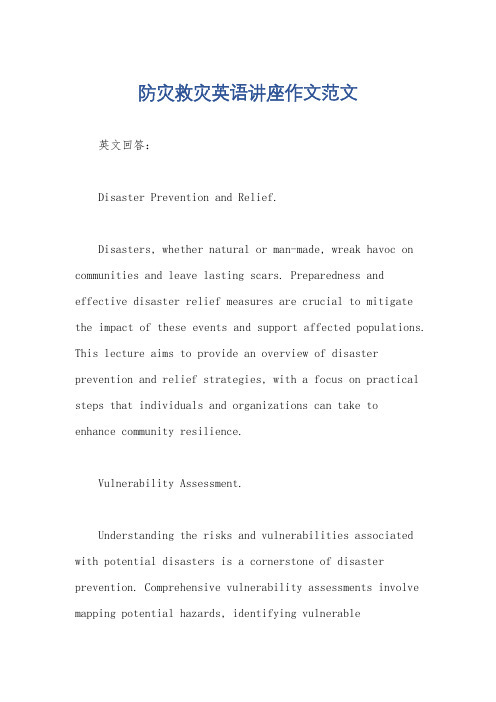
防灾救灾英语讲座作文范文英文回答:Disaster Prevention and Relief.Disasters, whether natural or man-made, wreak havoc on communities and leave lasting scars. Preparedness and effective disaster relief measures are crucial to mitigate the impact of these events and support affected populations. This lecture aims to provide an overview of disaster prevention and relief strategies, with a focus on practical steps that individuals and organizations can take to enhance community resilience.Vulnerability Assessment.Understanding the risks and vulnerabilities associated with potential disasters is a cornerstone of disaster prevention. Comprehensive vulnerability assessments involve mapping potential hazards, identifying vulnerablepopulations, and assessing the capacity of communities to respond to and recover from emergencies. By pinpointing areas of high risk, resources can be targeted to strengthen infrastructure, improve early warning systems, and implement mitigation measures.Disaster Preparedness Plans.Well-developed disaster preparedness plans provide guidance on how to respond effectively to various types of emergencies. These plans should outline clear roles and responsibilities for individuals, response organizations, and community leaders. They should also include evacuation routes, communication protocols, and procedures for providing critical services such as medical care, shelter, and food. Regular training and drills help ensure that all stakeholders are familiar with their roles and can execute the plan efficiently.Community Education and Awareness.Raising awareness about disaster risks and preparednessmeasures is essential for building community resilience. Educational campaigns should target all segments of the population, particularly vulnerable groups such as the elderly, children, and individuals with disabilities. Information should be tailored to specific local hazardsand provide clear instructions on what to do before, during, and after a disaster.Disaster Relief Operations.When disaster strikes, swift and coordinated relief operations are vital. Emergency response teams should prioritize search and rescue efforts, provide immediate medical assistance, and distribute essential supplies. Coordination between different agencies, including government organizations, non-governmental organizations, and community groups, is crucial to ensure efficient resource allocation and avoid duplication of efforts.Long-Term Recovery and Rehabilitation.The aftermath of a disaster requires sustained effortsto support affected communities in rebuilding their lives and livelihoods. Long-term recovery and rehabilitation programs focus on infrastructure reconstruction, economic revitalization, and psychosocial support for survivors. Community input and participatory approaches are essential to ensure that recovery plans meet local needs and priorities.International Collaboration.Disasters often transcend national boundaries, requiring international collaboration for effective response and relief. International organizations, such as the United Nations, play a vital role in coordinating disaster assistance, providing financial support, and facilitating the deployment of experts to affected areas.Conclusion.Disaster prevention and relief require a multifaceted approach that involves comprehensive planning, community education, coordinated response, and sustained recoveryefforts. By investing in resilience and preparedness, communities can mitigate the impact of disasters and build a more resilient future.中文回答:防灾救灾。
防灾救灾讲座英语作文
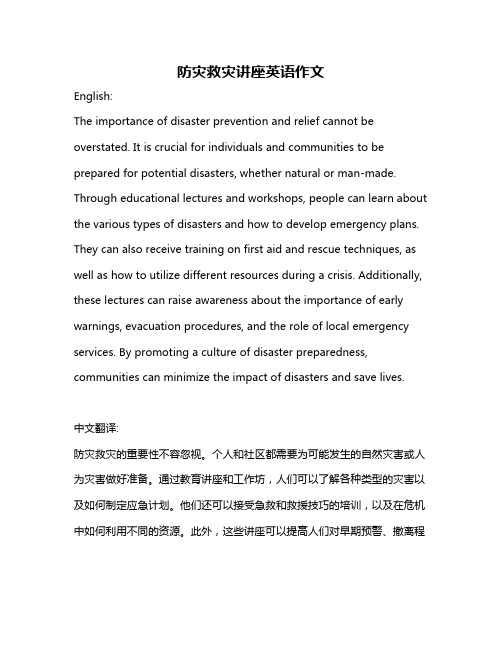
防灾救灾讲座英语作文English:The importance of disaster prevention and relief cannot be overstated. It is crucial for individuals and communities to be prepared for potential disasters, whether natural or man-made. Through educational lectures and workshops, people can learn about the various types of disasters and how to develop emergency plans. They can also receive training on first aid and rescue techniques, as well as how to utilize different resources during a crisis. Additionally, these lectures can raise awareness about the importance of early warnings, evacuation procedures, and the role of local emergency services. By promoting a culture of disaster preparedness, communities can minimize the impact of disasters and save lives.中文翻译:防灾救灾的重要性不容忽视。
个人和社区都需要为可能发生的自然灾害或人为灾害做好准备。
通过教育讲座和工作坊,人们可以了解各种类型的灾害以及如何制定应急计划。
人为灾害作文英文
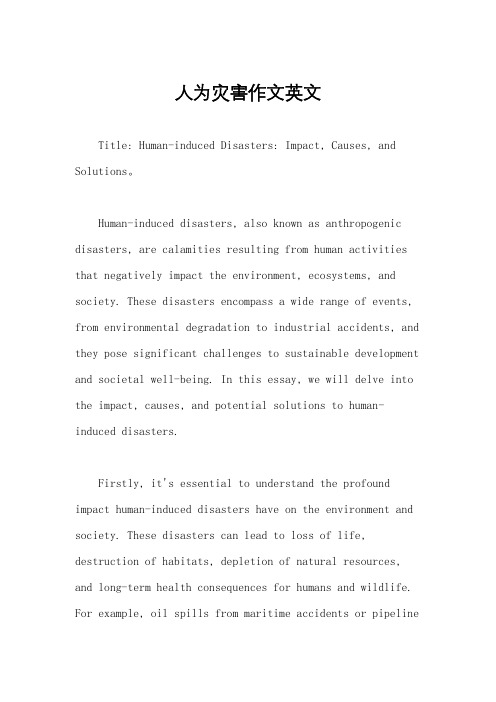
提升宝宝数学才能的几个方法提升宝宝数学才能的几个方法1、看一看a、数字之旅当您带着宝宝逛街、远足或外出旅行,让宝宝看着道路的标示牌、店铺的招牌和广告牌,看见了数字就大声地读出来。
这样一来,宝宝在进入幼儿园之前就可以有数字的概念。
另外还有,在排队时数数队列里的人数;回家路上的梧桐树的`数目;或者上楼也别忘记和宝宝一起数数楼梯的台阶哦!b、厨房里的数学题您可以拿一本儿童菜谱,让宝宝挑一道喜欢的点心或菜式,由您给他做。
然后,您可以要求他负责准备原料。
给宝宝标有刻度的量杯、小碗和调羹,让他准备10毫升的水、4碗面粉或2勺糖,假如宝宝不理解计量单位,您可以简单告诉他,看着量杯上的数字,学着计算适宜的分量。
2、听一听a、问候在一些节假日里,您可以列出一张朋友和亲戚的单子,依次给他们打个问候。
您可以拿着念号码,由宝宝拨通。
当然,您也可以和宝宝换一下分工,由宝宝大声地念出纸上的号码,您负责拨。
或者您可以在平时多注意,让他记住家里的和爷爷奶奶家的,训练宝宝记忆不规那么的数字组合。
b、儿歌里的数字您需要挑选一些带有数字的儿歌和童谣教给宝宝,例如:“我说1,1张纸来1支笔,学习数学做练习,都要用到纸和笔。
我说2,身上长着多少2?左边右边数一数,眼睛、手脚和耳朵。
”这些带数字的儿歌给了宝宝根本的数字概念,让他理解到学数学不单是做题目和上课,在游戏和唱歌的时候,也可以学到数学的知识。
3、做一做a、找出家具的形状引导宝宝在家里玩耍时,注意观察每个房间里的家具,它们都有着怎样的各式形状。
您可以乘机教诲宝宝学习几何学里的根底概念,如四方形、三角形、圆形和五角形等。
同时,您还可以告诉宝宝:2个三角形能组成1个四方形;1个圆形可以分成2个半圆形等等。
b、归类游戏您可以将家里的毛巾、浴巾、手帕和袜子等混合在一起,让宝宝根据不同的颜色、大小分成几个组,如按色彩分类,蓝色组里有蓝毛巾、蓝袜子等;您还可以提问,蓝色组里包括了多少东西呢?引导宝宝数一下,然后他能得出答案,如有2条蓝毛巾、1条蓝手帕和3双蓝袜子,蓝色组里一共有6件东西。
有关人为灾害的英语作文
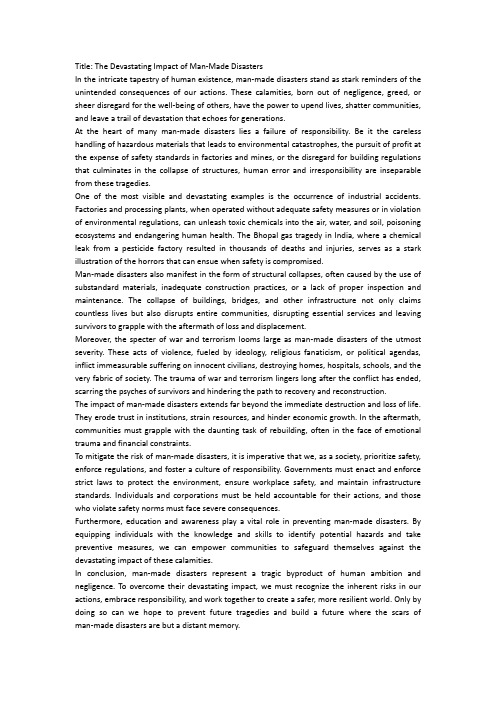
Title: The Devastating Impact of Man-Made DisastersIn the intricate tapestry of human existence, man-made disasters stand as stark reminders of the unintended consequences of our actions. These calamities, born out of negligence, greed, or sheer disregard for the well-being of others, have the power to upend lives, shatter communities, and leave a trail of devastation that echoes for generations.At the heart of many man-made disasters lies a failure of responsibility. Be it the careless handling of hazardous materials that leads to environmental catastrophes, the pursuit of profit at the expense of safety standards in factories and mines, or the disregard for building regulations that culminates in the collapse of structures, human error and irresponsibility are inseparable from these tragedies.One of the most visible and devastating examples is the occurrence of industrial accidents. Factories and processing plants, when operated without adequate safety measures or in violation of environmental regulations, can unleash toxic chemicals into the air, water, and soil, poisoning ecosystems and endangering human health. The Bhopal gas tragedy in India, where a chemical leak from a pesticide factory resulted in thousands of deaths and injuries, serves as a stark illustration of the horrors that can ensue when safety is compromised.Man-made disasters also manifest in the form of structural collapses, often caused by the use of substandard materials, inadequate construction practices, or a lack of proper inspection and maintenance. The collapse of buildings, bridges, and other infrastructure not only claims countless lives but also disrupts entire communities, disrupting essential services and leaving survivors to grapple with the aftermath of loss and displacement.Moreover, the specter of war and terrorism looms large as man-made disasters of the utmost severity. These acts of violence, fueled by ideology, religious fanaticism, or political agendas, inflict immeasurable suffering on innocent civilians, destroying homes, hospitals, schools, and the very fabric of society. The trauma of war and terrorism lingers long after the conflict has ended, scarring the psyches of survivors and hindering the path to recovery and reconstruction.The impact of man-made disasters extends far beyond the immediate destruction and loss of life. They erode trust in institutions, strain resources, and hinder economic growth. In the aftermath, communities must grapple with the daunting task of rebuilding, often in the face of emotional trauma and financial constraints.To mitigate the risk of man-made disasters, it is imperative that we, as a society, prioritize safety, enforce regulations, and foster a culture of responsibility. Governments must enact and enforce strict laws to protect the environment, ensure workplace safety, and maintain infrastructure standards. Individuals and corporations must be held accountable for their actions, and those who violate safety norms must face severe consequences.Furthermore, education and awareness play a vital role in preventing man-made disasters. By equipping individuals with the knowledge and skills to identify potential hazards and take preventive measures, we can empower communities to safeguard themselves against the devastating impact of these calamities.In conclusion, man-made disasters represent a tragic byproduct of human ambition and negligence. To overcome their devastating impact, we must recognize the inherent risks in our actions, embrace responsibility, and work together to create a safer, more resilient world. Only by doing so can we hope to prevent future tragedies and build a future where the scars of man-made disasters are but a distant memory.。
- 1、下载文档前请自行甄别文档内容的完整性,平台不提供额外的编辑、内容补充、找答案等附加服务。
- 2、"仅部分预览"的文档,不可在线预览部分如存在完整性等问题,可反馈申请退款(可完整预览的文档不适用该条件!)。
- 3、如文档侵犯您的权益,请联系客服反馈,我们会尽快为您处理(人工客服工作时间:9:00-18:30)。
Today my topic is man-made disaster.
In the world, there are natural disasters, ecological disaster, man-made disasters.
In the natural disaster such as the tsunami, earthquakes and floods, some of the damages are unavoidable, while the man-made disaster is more horrible. Now let me say some about the man-made disasters.
Man-made disasters, it is our own creation. Perhaps some cause that, but make more to bear. The individual feels now nothing, but the disaster is difficult to predict, such as food safety accidents, terrorist attack and so on.
Global warming is a representative of man-made disaster. Now I come to introduce some of the information about it.
In recent years the population increasing that cause global warming is one of the major factors. At the same time, it also makes a serious threat to the balance with natural ecological environment. So many people, only their emissions of co2 will be a surprising number, with factory and car sending out, and their result will be directly causing system of carbon dioxide in the atmosphere, thus formed constantly increased carbon dioxide "greenhouse effect" on the surface of the earth will directly affect the climate change.
At present, the sea is constantly a rising trend, according to experts predict that the next century, the sea level could rise 50cm. If you don't take measures, and freshwater resources will directly cause the destruction and pollution, etc.
Global warming is now no one doubts that global warming is caused by the people. Even if global warming can control a few, but the impact of the disaster is certainly nothing before. Over the years, the disaster was very slow, so that people have noticed it. But now, everyone can see: global ice is melting, sea-level rise, the southwestern United States, Australia, and sub-saharan African drought. Although these disasters incompletely caused by global warming, still to some degree, and they also will be increasing with global warming, eventually, that is endangering the survival of mankind.
The fundamental method is to reduce carbon emissions, such as reducing
population, reducing fossil fuels( coal, oil and gas, etc.), using more new energy (light and water, wind, etc), more creature planting green plants to absorb carbon and give off oxygen to improve the condition, etc. _ et cetera
Since is a man-made disasters, I think we should solve that from the start. Let us make a little contribution to the society, making our motherland more beautiful.
这个世界上,有自然灾害、生态灾难,天灾人祸。
在自然灾害如洪水、地震和海啸损失的,有些是不可避免的,而在天灾人祸更可怕。
现在让我说些关于天灾人祸。
天灾人祸,它是我们自己创造的。
也许一些原因,但让更多的熊。
个人觉得现在没什么,但这场灾难难以预测,如食品安全事故、恐怖袭击之类的东西。
全球变暖是最具代表性的天灾人祸。
现在我来介绍一些关于它的信息。
近年来的人口增长是造成全球变暖的一个重要因素。
同时,这也使得一个严重的威胁,与自然生态环境的平衡。
如此多的人,只有他们的排放的二氧化碳会被一个惊人的数字,工厂和汽车送出去,其结果将直接导致系统的二氧化碳在大气中,从而形成了不断增加的二氧化碳“温室效应”在地球的表面,将直接影响气候的变化。
目前,海是不断上升趋势,根据专家预言,到下个世纪,海平面上升50厘米。
如果你不采取措施,将直接导致了淡水资源的破坏和污染等。
全球变暖是现在没有人怀疑全球变暖的原因是由于人们。
即使能控制全球变暖的影响,但肯定是什么灾难。
在过去的几年里,这场灾难很缓慢,所以,人们都注意到了这一点。
但是现在,每个人都可以看到:全球冰融化,海平面上升,美国,澳大利亚和撒哈拉以南的非洲的干旱。
虽然这些灾害造成的全球变暖,论者仍然在某种程度上,他们也会增加与全球变暖,最终危及人类的生存。
基本方法是减少碳排放,例如减少人口减少化石燃料(煤、石油和天然气,等等),使用更多的新能源(光和水,风,等等),更多的生物种植绿色植物吸收二氧化碳放出氧气,改善状况,等。
_双键中
既然是天灾人祸,我认为我们应该解决的起点。
让我们做一个小对社会有所贡献,使我们的祖国更美丽。
